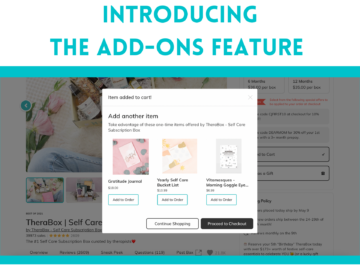Deciding how to price your subscription box is an important part of starting your business. It’s here that you pay for your product and make profits to pay your staff. Moreover, the box price you set can indicate your value proposition and even attract (or alienate) different types of customers.
Clearly, the price you decide on shouldn’t be an arbitrary number. Take the following lessons and apply them to your own subscription business.
In Brief: The Basic Psychology of Pricing (& Billing)
When thinking about how to price your subscription box, it’s important to factor in the actual science behind how people decide to buy something. Several factors come into play, but at the core, cost drives consumption, and pricing drives perceived cost. While everyone is different, most people want to feel like they got a good deal. Preferably, they want to feel like they got a great deal.
Consider these basic assumptions when thinking about pricing. If you’re developing a lower-priced box, be careful that your brand doesn’t come off as cheap or misguided – that could mean lack of quality and thus a bad deal. (After all, even $1 can feel “wasted” on a bad product.) Likewise, if you’re developing a higher-priced box, try to demonstrate an experience and value proposition worth investing in.
Now, look at your estimated box price. What would you need in order to feel like you’re getting a great deal?
While this is a very simple way to understand how price affects consumer behavior, it shouldn’t be overlooked. By misstepping price in relation to perceived cost, you risk devaluing your brand, churning customers, or missing out on potential revenue.
A Note on Rebilling
Keep in mind that customers are more likely to consume right after they’ve purchased the product (for example, gym members attend more often after they’ve just made a membership payment). This is sometimes called a “sunk cost,” and correlates to customer behavior like renewing subscriptions.
For this reason, it’s wise to place your rebilling dates soon after your product arrives at the customer’s home. If you provide them with a good experience, the customer is more likely to see your box as an experience they don’t want to lose. In the eyes of a happy customer, the perceived cost becomes a missed opportunity next month.
Consider COGS: Cost of Goods Sold
You should look at two primary areas when determining a price: the cost of goods sold (COGS) and conversion rates & price sensitivity.
Cost of Goods Sold: This is the total cost of the service you provide — from sourcing products each month to box design, shipping, marketing, and fulfillment. If it takes you $20 to get your customers their product, that’s $20 in COGS. (Some business owners exclude shipping, but for the purpose of this exercise, include it.) Consider these points:
- Work backward when determining your costs. What types of products do you want to include? That is, what is your value proposition? Figure out the metrics behind your idea to determine your price range.
- If your COGS is $20, your service needs to cost customers at least $20. That minimum would cover costs, but leave you no room for profit. If you want a gross profit margin to equal 50% of your retail, then your box should cost $40: $20 toward COGS and $20 of gross profit.
- This leaves very little room for margin of error. Provide yourself with enough profit margin for padding each month in case an unforeseen issue occurs. Personally, I recommend building in at least a 50% profit margin.
Conversion Rates & Price Sensitivity
As mentioned above, price drives perceived cost. To some, that can mean rigid $ values. For example, $19.95 is considered a “hot zone” for impulse buying – it doesn’t feel like a lot of money, but in many ways, it is. Arguably, that should lead to higher conversions. However, it’s not always so black-and-white. Consider these points:
- Your Market: What are your competitors’ price points? Subscription businesses range widely, but most are relatively inexpensive. Compared to your competitors, will your price point create a higher perceived cost to your buyer?
- Your Product: Consider the value — monetary and otherwise — of what you offer. Is your product unique and hard to compare to others? If so, how might that benefit or hurt your business? Do your products inherently have a $ value associated with them (i.e. “$100 value, guaranteed”), so the customer gets a bargain by subscribing?
- Your Added Value: What have you done to add prestige to your brand? Reconsider your marketing strategy — perhaps reaching out to influencers popular in your niche community would boost the shine of your brand. Do you offer benefits outside of regular delivery? How do customers perceive this?
Subscription businesses that can answer these questions are more likely to develop a less price-sensitive product than those that cannot.
We advise that you price your subscription boxes around impulse buy zones. These are often associated with nearly whole numbers, like $39.95 or $29.95. Because consumers tend to understand these prices more, while seeing them as costing “less” than whole numbers, you might increase conversions by applying this pricing technique to your business.
Once you establish overall costs and determine your price sensitivity, experiment to find an acceptable box price. Test this price with others – ask for feedback and evaluate the perceived costs they report without directly asking them.
You can also check your pricing with Cratejoy’s pricing guide calculator. This tool helps you to consider all your costs, then generate suggested pricing using a variety of profit margins.
Start your own subscription box: Click here to download the Cratejoy Subscription Box Business Plan
Different Types of Pricing: Are Multi-Month Options “Better”?
It’s tempting to offer multi-month subscriptions – that is, subscriptions that renew every 3, 6, or 12 months. Rather than charging monthly, you offer subscribers the opportunity to prepay for a set of shipments. Many subscription box business owners even decide to offer slight discounts on these extended options.
So, is this better? What are the pros and cons?
Pros of Prepaid, Multi-Month Subscriptions
Automatically Increased Retention: You keep those customers — automatically — for the length of time they’re subscribed.
Increased Revenue (Sort of): When a customer prepays, you increase revenues at the time of sale (since you’re collecting several months’ payment in advance). But if you offer a discount, you’re actually getting less revenue from that customer than if they stayed on month-by-month for the same time period.
More Options May Feel Better for Some. Providing more options for your customers could increase the likelihood that they make a purchase.
Cons of Prepaid, Multi-Month Subscriptions
Customer Service Implication: What if a customer purchases a yearlong subscription and decides partway through that your box isn’t for them? What if they request a refund? This possibility means your staff must spend time either solving the customer’s problem or explaining your policy.
Lumpy Revenue: By staggering subscribers, your cash flow will become more “lumpy,” with different sets of subscribers being billed at different times. For example, if 50 quarterly subscribers sign up in May, but only 5 in June, your August rebilling (for 50) will be higher than September rebilling (for 5). But this only poses a problem if you do not accurately account for it in your cash planning. If you overspend, for example, that means you’ve likely used past income — which you need to cover future costs. It’s not a good position to be in.
More Options Aren’t Always Better. I’m not convinced more options are always better, and neither are researchers at Stanford. determined that for a single product type (like jams), more options served as a drag on buying behavior. While this effect may vary from business to business, a multi-month subscription could lead to your customer debating how much your product is “worth it.” That can increase the likelihood your customers won’t convert.
In the end, neither option is truly “better.”
If you can lift overall retention of your customer base by offering multi-month options, without risking healthy cash flow, then multi-month subscriptions are the better choice. If you find retention growing naturally or you prefer simpler cash planning, then month-by-month subscriptions may be wiser.
That being said, you might offer multi-month options to market gift subscriptions. Since these are likely a smaller portion of sales, this won’t impact your cash flow as much. Also, these customers are probably more likely to churn more quickly than subscribers who enroll on their own. Multi-month options, in this case, might capture revenue from an ordinarily skeptical customer.
Price Your Subscription Box Wisely
While figuring out your box price may feel cumbersome, it’s too important to ignore. Pricing your product accurately will contribute to customer happiness, which contributes to the success of your business.
If you established a price, but aren’t sure about it, provide questionnaires or special offers to customers. Try to pry out details – which price points seem to resonate best with your audience? Which offers perform well consistently? When you practice diligence in pricing, you set your business up for a strong, sustainable stream of revenue.
Cratejoy is an all in one subscription commerce platform that includes everything you need to start your own subscription commerce business online. Try it free for 14 days.






